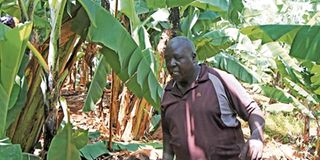Farmer dumps coffee for profitable bananas

Meshack Monari on his banana farm in Nyamira County. Together with his wife, today the couple has a total of 1,320 banana stems. The produce is mostly distributed to the nearby markets of Chabera, Ikonge, Sondu and in Kisumu. PHOTO | RICHARD MAOSI | NATION MEDIA GROUP
What you need to know:
- On realising that cultivation of bananas was a good venture, he pumped in some Sh30,000 from his savings. The money went to expansion of his banana farm, land preparation, planting and labour.
- Before planting the suckers, Monari added calcium ammonium nitrates (CAN) fertiliser alongside farmyard manure in the same hole to foster growth.
- Using a forked branch, he clips almost to the point of attachment between the stalk and the banana. He says this ensures that the bunch does not fall to the ground.
- Monari has also dug a well in his compound. The water is pumped to the farm during the dry season.
Some 6.5 kilometres from Nyamira town, along the Ikonge-Chabera highway in Nyamusi village, is Monari Farm.
The Seeds of Gold team finds Meshack Monari on his banana farm, which sits on part of his 4.5-acre piece of land, using a Y-shaped branch to support a banana stem.
Out of the 4.5 acres, two are set aside for farming, mainly traditional green bananas, which are in high demand in the region due to their nutritional value.
Monari, a father of three, shifted from coffee to banana farming in 2006. He started with just eight suckers he bought from a neighbour at Sh25 each, who inspired him to start small.
“I decided to clear the coffee plantation when I realised the hustle was not rewarding. I was discouraged by relatively low market prices of Sh20 per kilo and I had to look for an alternative way to sustain my family," reveals Monari who also rears chicken, four heads of dairy animals and grows managu (African nightshade).
On realising that cultivation of bananas was a good venture, he pumped in some Sh30,000 from his savings. The money went to expansion of his banana farm, land preparation, planting and labour.
A well-prepared farm requires plant spacing of 1.5 metres and a depth of 50 centimetres.
Before planting the suckers, Monari added calcium ammonium nitrates (CAN) fertiliser alongside farmyard manure in the same hole to foster growth.
Initially, things did not go as expected as weevils and moles began to attack the tender roots of the suckers.
He was forced to incur additional costs totalling Sh1,500 to purchase traps to get rid of nematodes. This was supplemented by using wood ash to drive away weevils and termites.
Today, Monari and his wife have a total of 1,320 banana stems. The produce is mostly distributed to the nearby markets of Chabera, Ikonge, Sondu and in Kisumu.
“Occasionally, we pool our produce and sell as a group. This takes place mostly between April and June when demand is higher than supply,” he says.
However, he reveals that with the Covid-19 pandemic, brokers have been moving from one farm to another collecting bananas at a much lower price of Sh250 per bunch, down from Sh500.
“Since the advent of the pandemic, most of the bananas are sold locally at a throwaway price.
Due to the perishability of bananas, I am forced to sell at Sh300 per bunch,” says Monari who uses his pick-up to ferry the produce to the market.
In a week, Monari harvests between 35 and 40 bunches.
BANANA BOOM
He says harvesting depends on the maturity of the produce. “Maturity can be determined by the appearance of the banana; a mature banana is dark-green while immature banana is light green,” he notes.
Using a forked branch, he clips almost to the point of attachment between the stalk and the banana. He says this ensures that the bunch does not fall to the ground.
Monari transports his harvest to the store and covers it with leaves, from where it is distributed to the market.
Before the dip in banana prices, a small-sized bunch fetched Sh500 while large-sized ones were sold for between Sh900 and Sh1,200.
“Bananas can also be ripened and be sold for Sh700 per bunch,” he says.
Monari also sells banana stems to dairy farmers at Sh50 per kilogramme.
Besides catering for his family's needs, he also employs four workers who help in harvesting, packaging and distributing the produce to the market.
In Kisii County, there is a banana boom between September and November, when the amount of rainfall is moderate and the duration of sunshine is sufficient.
Moreover, for proper management of his produce, he also practices mulching using dry grass and leaves to avoid the excessive loss of water between November and March.
Monari has also dug a well in his compound. The water is pumped to the farm during the dry season.
“Bananas take seven months to mature. When the bunch is deep green, you should harvest it to avoid being eaten by birds or stolen by thieves," he says.
Monari notes that banana plants also produce many suckers that can be sold.
Kelvin Gathee, a horticulturist and researcher from Kakuzi Horticulture Packhouse in Thika town, says bananas can do well in a wide range of soils as long as they are well drained and fertile, with adequate moisture content.
In addition, the farmer needs to understand the influence of factors such as pests, diseases, labour input and other expenses such as transportation.
However, availability of ready market should be given priority as it determines the bargaining power of the farmer.
It is important for a farmer to plant banana varieties with better yields and disease-free.
Tissue culture banana give higher yields compared to traditional varieties and are highly resistant to diseases.
“The fast-maturing banana variety weighs up to 70 kilogrammes when taken good care of and this will fetch good market prices,” he says.
****
Advice
Things to consider in banana growing
Kelvin Gathee, a horticulturist, says bananas can do well in a wide range of soils as long as they are well-drained and fertile, with adequate moisture content.
He says a farmer needs to understand the influence of factors such as pests, diseases, labour input and other expenses such as transportation.
Availability of ready market should also be given priority.





